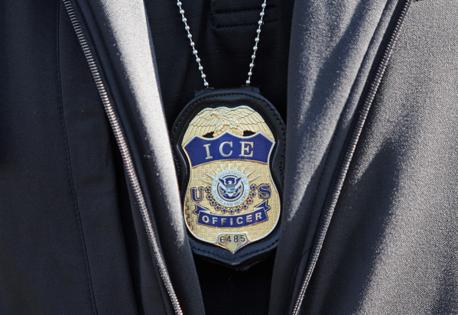What the data say about who ICE is arresting in San Diego
Published in News & Features
In the first six months of the Trump administration’s push for mass deportations, more than half of the U.S. Immigration and Customs Enforcement arrests in San Diego and Imperial counties were of individuals with no criminal charges or convictions, according to data from the federal agency obtained by the Deportation Data Project.
The data, which the project obtained via public records requests, helps show how President Donald Trump has carried out his crackdown on illegal immigration and provides a snapshot of who ICE has arrested in the region — during the initial months of enforcement as well as a more recent ramp-up marked by community pushback and videos of public arrests that go viral.
So far this year, ICE’s San Diego field office, which encompasses San Diego and Imperial counties, has made nearly twice as many arrests as it did last year — mostly of Mexican nationals, according to the data.
From January to early June, ICE’s San Diego field office made 1,042 arrests, compared to 602 last year and 191 in 2023. The project’s data goes through June 10, and only includes administrative immigration arrests made by ICE’s Enforcement and Removal Operations, or ERO, the agency’s main arm that enforces immigration policy.
The figures also show that so far this year, about 53% of ICE arrests locally have been of people with no criminal charges or convictions, 33% had criminal convictions, while about 15% faced pending criminal charges. That’s a notable difference from last year, when 74% of arrests locally involved individuals with a criminal conviction or charges pending.
The Trump administration had said in its initial deportation push that it was focusing on those with criminal histories who pose a threat to public safety.
“The focus is on criminal aliens that have violated the laws of the U.S. and put the American public in harm’s way,” the ICE ERO San Diego field office posted in late January on its X account. “Our priority is ensuring the safety of the American public against all criminal threats and ensuring the integrity of the lawful immigration system.”
The Department of Homeland Security reiterated that ICE was targeting “the worst of the worst,” saying in April that 75% of the arrests nationwide were “criminal illegal aliens with convictions or pending charges.”
But that appeared to have changed in recent months. With Trump unsatisfied at the pace of arrests and deportations, his administration reportedly set a daily arrest quota of 3,000 arrests, several media outlets reported, including NBC News.
The percentage of local ICE arrests of people without criminal convictions or charges increased significantly in May and June. While 20% of arrests in April were of individuals without criminal convictions or charges, it rose to 62% in May and 76% in early June, according to the data.
The data show that relatively few of the arrests, 14% so far this year, were through the Criminal Alien Program, or CAP, which ICE describes as focusing “on the identification, arrest, and removal of incarcerated aliens at federal, state, and local levels, as well as at-large criminal aliens.”
María Chávez, the immigration legal director at the Partnership for the Advancement of New Americans organization, or PANA, said she believes the increased quotas indicate that “it was never really about arresting people with criminal records.”
“Statistics show that, compared to U.S. citizens, immigrants commit very few crimes, comparatively speaking,” she said. “Well, if there aren’t 3,000 criminals or individuals with criminal history to arrest (per day), who are they going to go after to meet those quotas?”
Adriana Jasso, coordinator for the U.S.-Mexico border program with the American Friends Service Committee, said the data coincides with what local human rights advocates have observed while documenting arrests.
Jasso said they have noticed cases of “collateral arrests” involving individuals who were not the primary targets of federal agencies. She said that, in those cases, it is likely that the individuals had no criminal history.
When asked about the findings in San Diego, an ICE spokesperson said that the agency “is working diligently to implement the administration’s goals to clear the backlog of illegal aliens who pose a threat to the security of our communities.”
“Enforcement and Removal Operations are identifying, targeting, and apprehending those with criminal convictions or outstanding warrants as well as those who have illegally entered, reentered or have a final order of removal,” the spokesperson added.
DHS, ICE’s parent agency, has denied reports that ICE is not focused largely on individuals with criminal records. DHS also claimed that many of the undocumented migrants “are actually terrorists, human rights abusers, gang members and more — they just don’t have a rap sheet in the U.S.”
As of June 30, the Trump administration said it has arrested more than 273,000 undocumented immigrants nationwide.
ICE data as of June 10 obtained by the Deportation Data Project show fewer arrests nationwide, closer to 95,700 since Trump took office. Several other federal law enforcement agencies have also been tasked with making immigration arrests, including Customs and Border Protection, Homeland Security Investigations and the FBI, and it is unclear how those arrests are recorded.
The local data, meanwhile, show that Mexican nationals account for 65% of local ICE arrests this year. Jasso said that matches up with what her team has seen based on their documented cases and families who have contacted them for assistance.
Consul General of Mexico in San Diego Alicia Kerber attributed that trend to the fact that Mexican nationals make up the largest immigrant population in San Diego County.
Kerber said the number of detentions of Mexican nationals has remained steady. She said consulate representatives visit the detention centers in the county daily. “We are ensuring that our community’s rights are protected throughout the entire process,” she said.
ICE’s San Diego office has also arrested dozens who are from Guatemala, Venezuela, Vietnam and Colombia.
At least 39 of those arrested this year locally were children. Men made up 89% of the arrests.
Another shift in enforcement came in late May, when immigration advocates and attorneys noticed that individuals attending their immigration hearings were being arrested upon exiting court at the downtown federal building. In most cases, their cases were dismissed at the government’s request so they could be placed in an expedited removal process. This tactic has also been observed in other cities across the country.
Chávez with PANA said that three of her clients have been arrested outside of immigration court since June 10. “None of them had any criminal record, no criminal convictions of any kind in any country anywhere in the world,” she said.
Last week, a group of six California Republican legislators sent a letter to Trump, urging him to focus immigration enforcement efforts on undocumented immigrants who have committed violent crimes.
The group, which included San Diego lawmakers California Senate Minority Leader Brian Jones and Assemblymember Laurie Davis, also asked for changes to allow non-criminal individuals with long ties to the community a path toward legal status.
“We have heard from employers in our districts that recent ICE raids are not only targeting undocumented workers, but also creating widespread fear among other employees, including those with legal immigration status,” the letter sent on June 27 reads.
The group said that while supporting the enforcement of federal law, they asked Trump to “direct ICE and DHS to focus their enforcement operations on criminal immigrants, and when possible to avoid the kinds of sweeping raids that instill fear and disrupt the workplace.”
_____
©2025 The San Diego Union-Tribune. Visit sandiegouniontribune.com. Distributed by Tribune Content Agency, LLC.







Comments